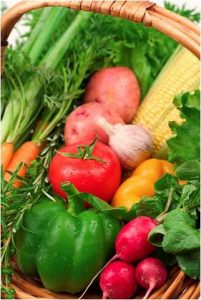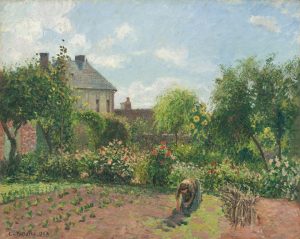
Fresh Vegetables. Credit: ConstructionDealMkting. (CC BY 2.0). https://www.flickr.com/photos/41608186@N06/4463639314.
‘To be rooted’, wrote French philosopher Simone Weil in The Need for Roots, ‘is perhaps the most important and least recognized need of the human soul’ (2002, 40). Writing at the height of the Second World War and shortly before her death, Weil argued that human beings need both material and moral nourishment for life. Food, housing, and heating, for example, may fulfil our physical needs but are not in themselves sufficient conditions for the optimal life of the soul (Weil 2002, 6). Human beings also require the balanced satisfaction of opposing needs: both order and liberty, for example, both security and risk (Weil 2002, 11). When a human being is uprooted, as Weil suggested was both the cause and the consequence of the tragic events of the first half of the twentieth century, she is cut away from a community and thus from the ‘treasures of the past and […] expectations for the future’ (2002, 40). This deracination is particularly prevalent in the brutal actions of war and colonialism, but also more subversively in modern capitalism and the dogmatic pursuit of economic gain (Weil 2002, 41).[1]
Today, of course, we can see how the Coronavirus situation affords a new form of ‘uprootedness’ – paradoxically, in many cases, by confining us to one location. The pandemic is not only a biomedical challenge but also a social affliction that has isolated us from many of the communal networks we previously took for granted. Both our sense of security and permanence and our dynamic possibilities for action and change have been affected to various extents. Of course, we have persevered and found new communal spaces in online groups and other digital collectives, but Weil’s organic metaphor for social belonging and wellbeing raises pertinent questions concerning our need for community.
An example of such uprootedness arose in my recent teaching of Arto Paasilinna’s The Howling Miller (2018; Ulvova mylläri 1981), as part of a comparative literature course on mental health in literature and film.[2] This witty, folkloric novel of constructed madness,[3] individuality, and conformity in post-war Finnish Lapland invites readings of uprootedness as an organic metaphor for madness and social marginalization. Physically and psychologically excluded from the community, the protagonist’s uprootedness both precedes and follows allegations of madness and badness. Rootedness, on the other hand, is to be found in the ecological and social sustainability of a vegetable patch, where root vegetables provide connections (back) to the community and to psychological wellbeing.
Paasilinna’s protagonist, Gunnar Huttunen, is uprooted. Although generally believed to have come to Lapland from south-west Finland, ‘no one was ever too sure exactly where he was from’ (Paasilinna 2018, 5), and Huttunen’s mysterious personal history – including the dissolution of his marriage, or, perhaps more literally, the dissolution of his wife – deprives him of the social roots that would ensure his individual continuity with others.[4] Huttunen’s participation in both Finnish wars of the twentieth century – the Winter War (1939–40) and the War of Continuation (1941–44) – is a further source of his sociocultural uprootedness, leading to a diagnosis of war neurosis while he is incarcerated in Oulu mental hospital (Paasilinna 2018, 89; 98–104). This uprootedness manifests itself in Huttunen’s erratic behaviour, at times suffering long periods of depression, at others delivering euphoric performances of storytelling or animal impressions.
Huttunen’s intrinsic uprootedness upon arrival in the village predisposes him to the suspicions of others. His unpredictable behaviour and tendency to howl ‘like a wild animal’ at night (Paasilinna 2018, 9) are perceived as symptoms of his uprootedness that serve to further dislocate him from the community who consider him dangerous and unreasonable, ‘afflicted by an incurable mental illness’ (276). Root vegetables, however, provide a means of (re)integration back into the local community as an economically and socially beneficial enterprise in the post-war countryside. On the advice of the local horticulture adviser, Sanelma Käyrämö, Huttunen converts some of the land surrounding his mill into a vegetable patch, where he plants beetroot, carrots, turnips, peas, onions, and herbs. As Huttunen is increasingly isolated from the rest of the village, he is banished to the surrounding forest where the vegetables from his own patch provide a source of nutrition and, perhaps most crucially, a connection to the human world.
In The Howling Miller, root vegetables afford a curative connection to others, to reason, and to civilization that would reroute – or, rather, reroot – Huttunen (back) into the community. A symbol both of the communal roots shared by others from which Huttunen finds himself physically and psychologically excluded, and of the desires to reintegrate the community, root vegetables signify the stability and active continuity so crucial to Weil’s concept of rootedness. Of course, I am not suggesting that we all begin growing vegetables in response to Coronavirus,[5] but rather than we think of the impact our contemporary uprootedness may have upon our wellbeing and how we may go about rerooting – or rerouting – our everyday lives. In Huttunen’s own words: ‘Thank God for vegetables’ (Paasilinna 2018, 118).

The Artist’s Garden at Eragny. Oil on canvas by Camille Pissarro. 1898. Credit: National Gallery of Art (CC). https://www.nga.gov/collection/art-object-page.52198.html
References
Arendt, Hannah. 1962. The Origins of Totalitarianism [1951]. Cleveland and New York: Meridian.
Foucault, Michel. 1993. Madness and Civilization: A History of Insanity in the Age of Reason [1961]. Translated by Richard Howard. London: Routledge.
Paasilinna, Arto. 2018. The Howling Miller [1981]. Translated by Anne Colin du Terrail and Will Hobson. Edinburgh: Canongate.
Weil, Simone. 2002. The Need for Roots: Prelude to a Declaration of Duties towards Mankind [1949]. Translated by Arthur Willis. London and New York: Routledge.
[1] Hannah Arendt similarly viewed the endemic climate of loneliness, homelessness, and rootlessness as breeding grounds for the rise of totalitarianism in the twentieth century as people sought meaning and belonging in the ‘fictitious home’ (1962, 381) of a ‘consistent, comprehensible, and predictable world’ (1962, 352) that would overcome the sense of ‘disintegration and disorientation’ (1962, 381).
[2] Before anyone falls off their chair in shock, I obviously taught this in English; students read in Finnish.
[3] The novel carries strong influences of Foucauldian constructivism in its presentation of Huttunen’s ‘madness’ (Foucault 1993).
[4] Huttunen claims that he lost his previous mill and wife in a fire; local records show him to be a batchelor (Paasilinna 2018, 5).
[5] If you are interested in growing vegetables, potatoes and salad leaves are a good place to start. Jerusalem artichokes (maa-artisokka) are also very easy but taste like dirt.
*Avril Tynan is a TIAS post-doctoral fellow (aatyna@utu.fi; Twitter @avitynan)

A great post, Avril. Thank you.